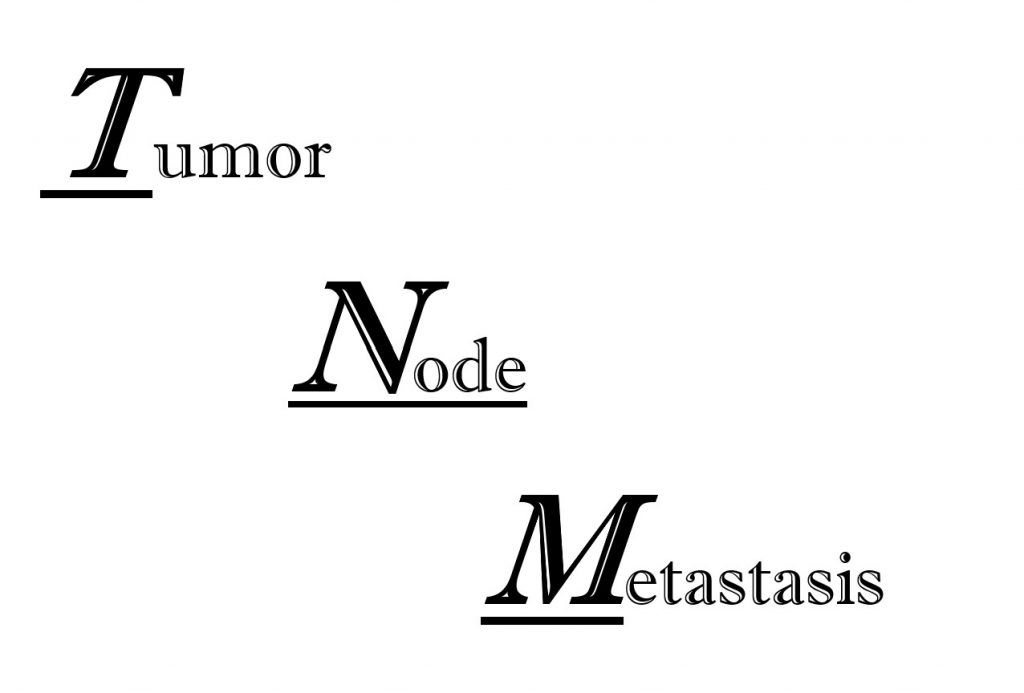The second staging system used for thymic cancer is the TNM system. This system can actually be applied to all cancers. It consists of three letters:

- Tumor (T): How large is the primary tumor? Where is it located?
- Node (N): Has the tumor spread to the lymph nodes? If so, where and how many?
- Metastasis (M): Has the cancer spread to other parts of the body? If so, where and how muchThe results are combined to determine the stage of cancer for each person.
Each of the letters are assigned a value from 0 to 4, or 0 to IV. The combination of letters and values describe the stage of the cancer.
Tumor (T)
Using the TNM system, the “T” plus a letter or number (0 to 4) describes the size and location of the tumor. Tumor size is measured in centimeters (cm). A centimeter is roughly equal to the width of a standard pen or pencil.
For example:
TX: The primary tumor cannot be evaluated.
T0 (T plus zero): No evidence of a primary tumor.
T1: The tumor is located only in the thymus or has grown into the nearby fatty tissues.
- T1a: The tumor has spread into fat surrounding the thymus or
- T1b: The tumor has grown into the lining of the lung next to the tumor (called mediastinal pleura).
T2: The tumor has grown into the nearby fatty tissue and into the sac around the heart, called pericardium.
T3: The tumor has spread to nearby tissues or organs, including the lungs, the blood vessels carrying blood into or out of the lungs, or the phrenic nerve, which controls breathing.
T4: The tumor has spread to nearby tissues or organs, including the windpipe, esophagus, or the blood vessels pumping blood away from the heart.
Node (N)
The “N” in the TNM staging system stands for lymph nodes. These tiny, bean-shaped organs help fight infection. Lymph nodes near where the cancer started are called regional lymph nodes. Lymph nodes in other parts of the body are called distant lymph nodes.
NX: The regional lymph nodes cannot be evaluated.
N0: The tumor has not spread into lymph nodes
N1: The tumor may have spread to nearby lymph nodes.
N2: The tumor has spread to lymph nodes deep in the chest cavity or neck.
Metastasis (M)
Finally, the “M” in the TNM system describes whether the cancer has spread to other parts of the body, called distant metastasis.
M0 (M plus zero): The disease has not metastasized.
M1: The tumor has spread to other organs near the thymus, such as the lung and blood vessels.
- M1a: The tumor has spread to the lining of the lung, called the pleura, or lining of the heart, called the pericardium
- M1b: The tumor may have spread to the lining of the lung or the heart.
For Those Who Want to Learn More
There are other notations that are part of the TNM system that describe the cancer further.
The pretreatment extent of disease is determined clinically with information collected from examination, laboratory tests, imaging and biopsy. This would be indicated with the letter “c” as in cTNM. Information from surgical excision and pathological examination of the entire primary tumor allows for a detailed post surgical pathologic would be indicated with the letter “p”, as in pTNM. In general TNM or cTNM is used to determine initial treatment strategy, while pTNM is used to determine the requirement for post surgical adjuvant therapy and follow up.
If neoadjuvant therapy is given prior to surgical resection, the cTNM or pTNM category is identified by a y prefix. The ycTNM or ypTNM categorizes the extent of tumor actually present at the time of that examination. The ypTNM considers only viable tumor cells and not signs of regressed tumour tissue such as scars, fibrotic areas, mucin lakes etc.
If patients receive neoadjuvant therapy prior to surgery or radiotherapy the TNM may not be same as if no neoadjuvant treatment was given. To overcome this problem the additional descriptor y can be used as a prefix to indicate the extent of disease at the time of assessment even if multimodality therapy has already commenced (i.e., yT1N0M0 means that the patient was staged following neoadjuvant treatment, and the anatomic extent of disease at that time was confined to the primary site, and of a size commensurate with the T1 category for that tumor type).
The R classification (RX, R0, R1, R2) may be used to describe the extent of residual disease after treatment usually after surgical resection